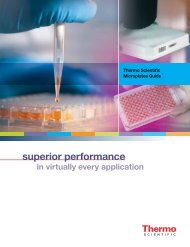PeloBiotech
You also want an ePaper? Increase the reach of your titles
YUMPU automatically turns print PDFs into web optimized ePapers that Google loves.
www.pelobiotech.com<br />
Pancreas<br />
We extract beta cells and diseased cells from diabetic<br />
patients from the pancreas. Additionally, we isolate<br />
endothelial cells, epithelial cells, fibroblasts, and PDX<br />
cancer cells from different pancreatic regions and various<br />
species. The uses of beta cells in research are extensive<br />
and diverse. Studies have focused on understanding the<br />
factors influencing beta cell turnover, proliferation, and<br />
functional state, particularly in the context of diabetes and<br />
regenerative therapy.<br />
Research has explored the essential role of Nkx6.1 in<br />
maintaining the functional state of pancreatic beta cells,<br />
adaptive changes in beta cell turnover during pregnancy,<br />
the relationship between beta-cell mass and obesity/type 2<br />
diabetes, and the gene regulatory network required for<br />
establishing and maintaining pancreatic beta cell identity.<br />
Additionally, the beta cell workload hypothesis has been<br />
revisited in the context of type 2 diabetes, and<br />
mathematical modeling has been used to estimate the long lifespan and low turnover of human islet beta cells.<br />
Studies have investigated the proliferation of sorted human and rat beta cells, targeted insulin-producing beta cells for<br />
regenerative therapy, and explored the potential for beta cell regeneration in aging pancreatic beta cells. Single-cell RNA<br />
sequencing has revealed a role for reactive oxygen species and peroxiredoxins in fatty acid-induced rat beta-cell<br />
proliferation, and reciprocal modulation of adult beta cell maturity by activin A and follistatin has been studied. Moreover,<br />
research has focused on beta cell regeneration after immunological destruction in a mouse model, explored the potential<br />
for making better beta cells, and investigated agents inducing both alpha and beta cell proliferation without affecting<br />
differentiation or viability. Additionally, efforts have been made to expand human beta cells, and heterogeneities of normal<br />
and stimulated pancreatic beta cells have been examined. These studies collectively contribute to a comprehensive<br />
understanding of beta cell biology and its implications for diabetes and regenerative medicine.<br />
Lungs and Oral cavity<br />
Apart from isolated and iPS derived alveolar and<br />
bronchial epithelial cells, fibroblasts, smooth muscle<br />
cells, macrophages, endothelial cells PDX cancer cells,<br />
mesenchymal stem cells from different regions of the<br />
heart and various species. The uses of iPS-derived<br />
alveolar and bronchial epithelial cells, fibroblasts,<br />
smooth muscle cells, macrophages, endothelial cells,<br />
PDX cancer cells, and mesenchymal stem cells from<br />
different regions of the heart and various species are<br />
diverse and impactful in biomedical research. Patientderived<br />
xenograft (PDX) models have been extensively<br />
used in cancer research to simulate human tumor<br />
biology in vivo, aiding in the development of anticancer<br />
drugs and providing a better representation of tumor<br />
heterogeneity and the tumor microenvironment.<br />
Mesenchymal stem cells (MSCs) have shown promise in the treatment of chronic lung diseases and ischemic heart<br />
disease, with studies demonstrating their potential for myocardial survival and repair, as well as their ability to<br />
differentiate into endothelial cells, vascular smooth muscle cells, or cardiac-like myocytes when transplanted into the<br />
ischemic heart. Smooth muscle cells have been studied for their contractile properties and their association with neuroglial<br />
cells and interstitial cells of Cajal in intestinal tissue engineering. Additionally, endothelial and smooth muscle cells have<br />
been isolated and characterized from coronary vessels, providing insights into their contractile phenotype and potential<br />
applications in vascular research.<br />
15
















